I’m going to let you in on a secret: if you’re looking for B2B lead generation strategies, well, there’s no magic bullet. No button you can push. But you already knew that.
You’ve probably already read a handful of articles, giving you lists of things you can try, without much context. Well, you’ll find a list here too, but I want to try and put things into context a bit, before diving into the list.
If you’re a B2B marketer, or salesperson, feeding the lead machine probably keeps you up at night. Qualified leads are the lifeblood of nearly every business, both online and off.
P.S. Find a TL;DR summary in the end of the post if you’re in a rush.
What is lead generation?
To start with the basics, let’s get the definition of lead generation out of the way. According to Webopedia:
DEFINITION
Lead generation is a marketing activity that results in acquiring information useful for building a list of potential clients.
Today, the key channels for lead gen can be divided into two: online and offline. Some examples of online lead generation channels would include your blog and website, ads and SEO. The more commonly used offline channels are direct mail, trade shows and cold calling.
Lead generation is key to business success
In a recent research report, Copper and Outfunnel asked B2B sales and marketing leaders what they consider the key metrics for business success.
The number 1 metric? Quality of leads.
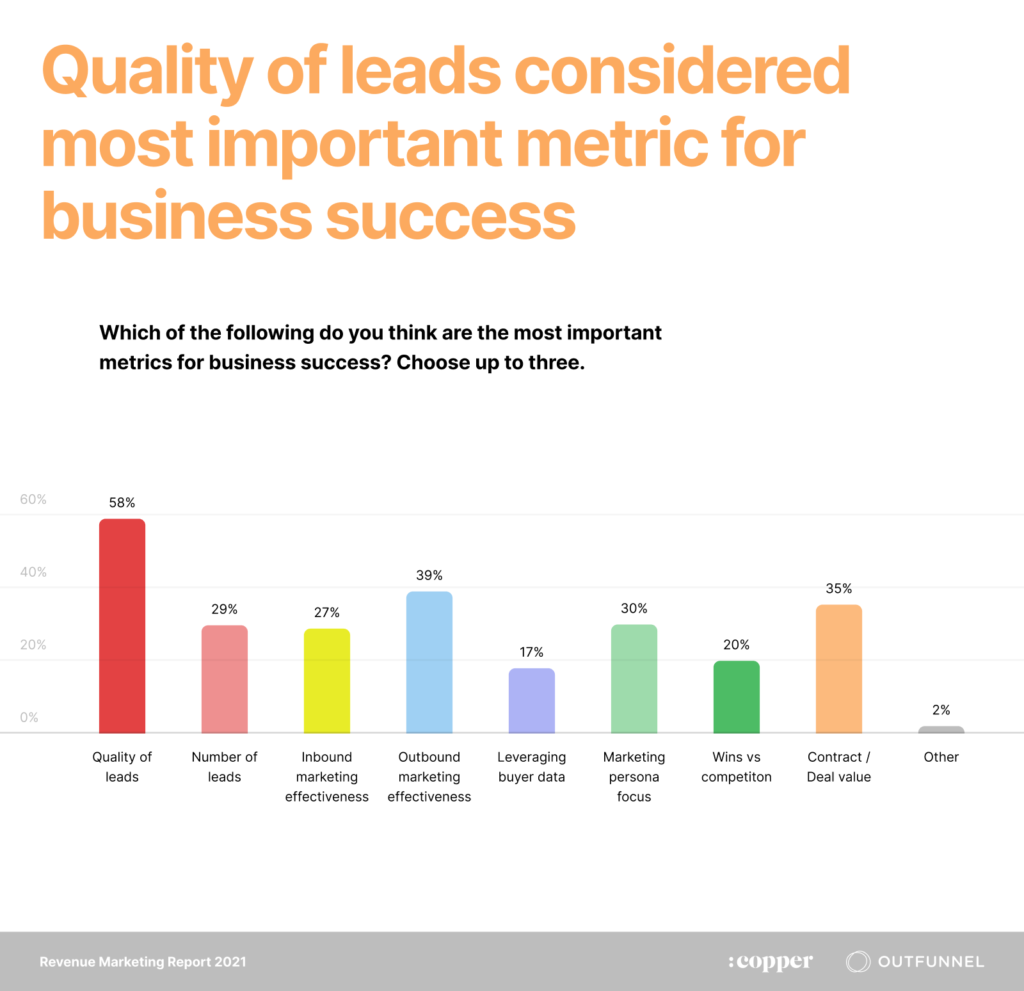
But where do companies get high quality leads?
The state of lead generation in 2021: what are the best sources of leads?
Everyone in B2B probably spends a lot of time in meetings, on Zoom calls, discussing where to get more high-quality leads. Or where existing leads are coming from.
But want to know another secret? Even the biggest names in the business don’t really know where their leads are coming from. Take a look at the graph below. It’s no surprise that all forms of inbound marketing do well for generating B2B leads, with email marketing and SEO (organic search and content marketing) leading the way.
Then cast your eyes to the right. “Other” is a semi-scientific way of saying: “Erm, we don’t know”.

Long story short: if you don’t know where your leads are coming from, you’re not alone. The blurriness of today’s digital landscape can make attribution really hard. Different devices, people logged in or not logged in. Using different browsers on different machines.
This makes it easy to get lost in a time sink where you’re endlessly hunting for total clarity when, really, your time is better spent planning your next move.
And remember, effective B2B lead generation is the sum of many moving parts, relying on planning and, frankly a ton of effort. For every story you hear of explosive, overnight growth from a single landing page or marketing campaign, there are a million more success stories that have been the result of consistent hard work. And besides, those “overnight success stories” are very rarely as instantaneous as we’re led to believe.
So, with this list I’m not saying “do all of these things and $$$$”. I’m saying build your lead generation strategy around your audience, ability, and budget.
Without further ado, let’s jump in and look at online B2B lead generation ideas.
Online B2B lead generation strategies
Looking for leads online? Here’s some ideas to generate leads in the digital world. And while some of them may seem obvious, sometimes it’s worth reminding ourselves that the answers are less complicated than they might seem.
1. Good ol’ email marketing
I have a lot of conversations with business people who are looking for some input on their marketing and, generally, it goes something like this:
“I don’t really have enough time or money for marketing, what can I do to get more leads without having to drop a lot of cash?”
My response: content and, most importantly, email.
According to Emma, 59% of marketers point to email as being their best channel for revenue generation. Okay, if you have someone on your email list of subscribers, they’re already potentially a lead, but email is vital for establishing (with little hands-on sales work and lead scoring in place) whether that lead is actually viable.
Sign up for our free crash course on B2B email marketing
Content brings in the volume, email helps you sort the wheat from the chaff. And, yes, you can use cold email outreach to generate B2B leads. Done properly (read: not spamming people), it can absolutely get those leads flowing in.
And, speaking of cold emails.
2. If you do cold email, put in the effort
Cold email is probably the most abused channel these days. Smart email marketers know to put in the effort, if and when they use cold email.
The first thing to work on is building a quality list. You can use a tool like Voila Norbert for that or explore other ways to find people’s email addresses.
And then comes the crucial part: properly cleaning the email list before even going near any email sending tools.
In fact, the only way to get good results with cold email is to first build a high-quality list. For example, Outfunnel recently launched the company’s first cold email campaign and the 33-51% open rates and 3-6% engagement rates (respectable results, no?) were direct results of the effort that went into cleaning and vetting the list.
Then, your emails need to stand out. In Outfunnel’s cold email experiment, personalization proved to be effective but at the minimum you can be “creative”.
Don’t be afraid to be different. Unusual, even. I would much rather drop in some quirkiness and have someone message me back, calling me out on using “quirky lead generation tactics” than be lost against a background of beige noise.
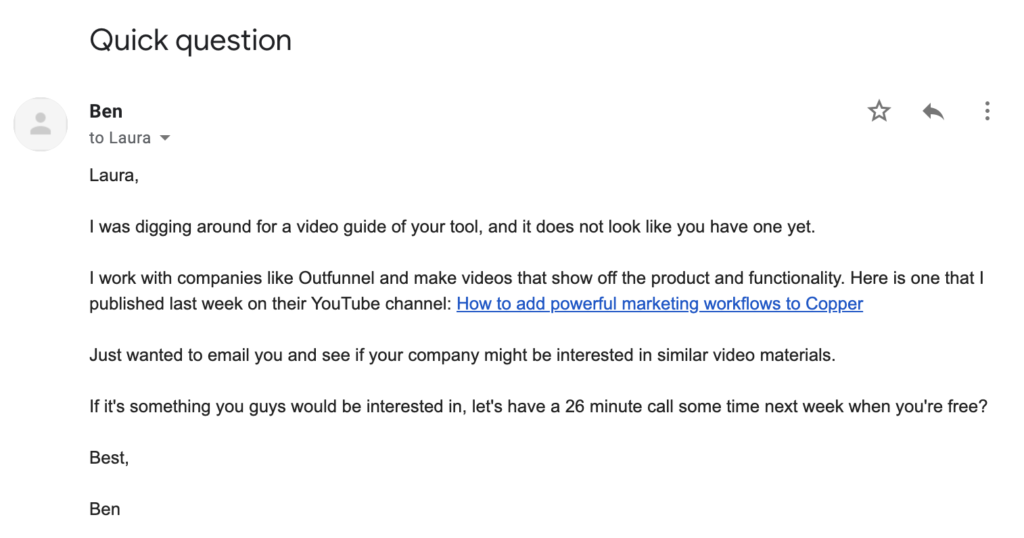
In this particular example, I said “let’s have a 26 minute call”, rather than a round number, and ended up getting called out on it. But the overall response rate went up by around 10-15% versus the “let’s have a quick call” version.
Don’t let the MBA write your cold outbound emails. Not that there’s anything wrong with MBA’s in particular, it’s just you often find a certain type of cold email, full of “synergizing business goals” and buzzwords coming from MBA-types. Let your creative people get their hands on the email copy and let them be creative.
Use images, gifs and experiment with pattern interrupts, something that breaks the regular pattern of a cold email and grabs their attention.
3. High quality content marketing (think eBooks, whitepapers and webinars)
Content can be awesome for B2B lead generation, but it comes with an armful of caveats. Good quality content arguably requires an order of magnitude more planning, resources, and just hard work than, say email.
High-quality case studies, infographics, eBooks and whitepapers can sometimes take months to put together, If you include the time it takes to gather data, analyze it then package all your findings into something actually useful.
Not to mention webinars or podcasts!
I’m not trying to scare you off using content to generate you leads, you absolutely should be doing it. Just spend a little bit more time planning it. Think “would I hand over my contact info for this?”. Ask other people the same question.
A particular favourite is taking some data that you may have within your business, anonymizing it, then doing a deep dive analysis.
Another favourite is taking whaterver original know-how you have and turning that into a resource. For example, Outfunnel’s CEO created a B2B email marketing course last year. He has 20+ years of experience in B2B marketing, and from customer interactions, it was clear that many need guidance.
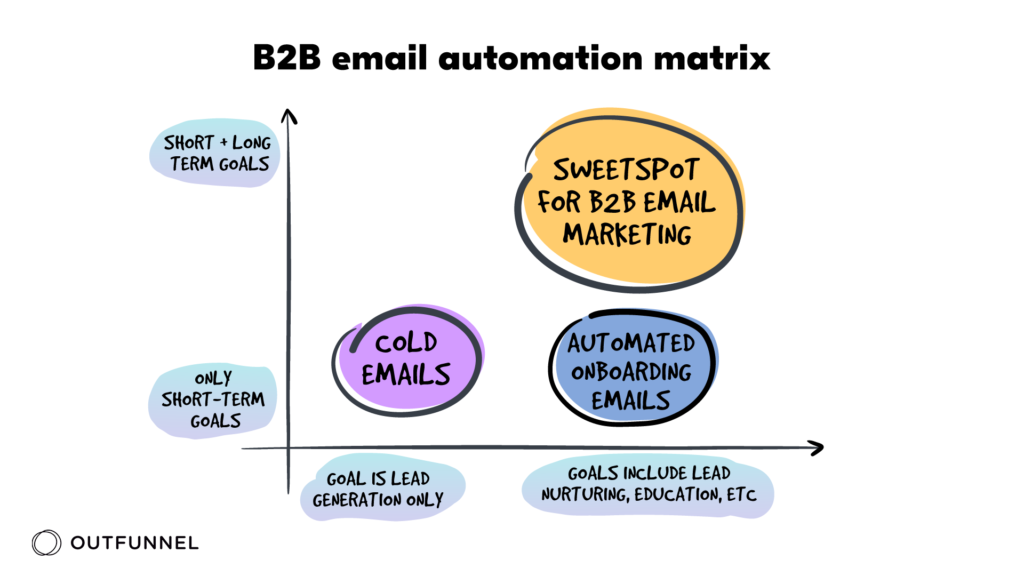
While the course did take several weeks to put together and polish, it does serve two goals really well. First, Outfunnel’s customer success team can share it with all the users who have less experience with email marketing, helping them win more. And second, as word about it spread, it delivered more than 400 highly qualified leads in just a few months.
And if you think all of this sounds too daunting or you don’t have resources available in-house, reach out to some freelancers and ask for help. There are armies of stellar marketers out there just itching to help you.
4. Better blogging
A common complaint I hear, mainly from sales-focused people is that their blog doesn’t generate enough leads. Either it’s not getting enough traffic, or it’s getting traffic that’s not converting into business results.
Well, here’s a slightly unhelpful, but somewhat necessary tip for you:
Be better.
Have a plan, and execute it well. Stop regurgitating other peoples’ opinions and start sharing your own experience. Write posts as a person, to be read by other people.
Great content doesn’t happen overnight, but with persistence it really can be the pillar of your B2B lead generation efforts.
A well thought out content marketing plan featuring an SEO-optimized blog will bring you the traffic and help them towards the bottom of the funnel at the conversion rates you like.
5. Tap into online social media communities (Facebook groups, LinkedIn, Reddit)
Generally speaking, social media marketing has a bad rap when it comes to B2B lead gen.
The truth is, social media be a great source of leads if you know where to look. And I strongly recommend looking into online communities on social media platforms where your target demographic hangs out.
More often than not though, a lot of these groups will forbid directly promotional content – always check the rules before posting something (on Reddit you can take a look at the sidebar, usually).
So how can you use these online communities for lead generation? Well, hunt down a few groups that seem relevant to the problem you’re trying to solve. Think “where does my target audience hang out?”. Take a look, go through the post history – make sure it’s not all spam, for example.
Then get subscribed and start engaging. Post questions, answer other people’s questions. A lot of groups you will actually find decision-makers posting looking for exactly the kind of thing you’re offering. Just direct message them (and make sure to reply to them in the comments, otherwise – on Facebook at least – they might not see the message).
Let’s take Web Design as an example.
I threw “web design and development” into the Facebook Groups search and these are the groups I found:
Best Web Designing & Development in WordPress And OpenCart
Web Development & Web Designing
There were a couple more but they were private (always worth asking to join though). Of those two, within the last 24 hours (at the time of writing) there were 4 different requests for web design and development services.
Literally, potential leads, just sitting there.
6. Build your own online community
Not only can having your own social netowrk community bring in business leads, it also allows you to really cement yourself as a thought leader.
My biggest piece of upfront advice here though would be—if you’re looking at this as a lead generation tool—don’t approach it from a branding perspective at all. Name it something not linked to your company at all.
Post as yourself, build your personal brand. Your own community is the perfect place to share unique content and target people who are likely having the specific problem you’re looking to solve.
What’s more, if you’re an early-stage, SaaS-type business, it’s often the perfect way of nurturing early adopters than you can later become your “brand champions” or influencers.
A word of caution though; communities like this will take time to grow. They, much like the content you will need to produce to feed them, are an investment in their own right. And once they get to the sort of scale you need for them to become a legitimate source of leads, you might even need to have a dedicated person to manage the community itself.
7. Fix your website
Your homepage is your shop window. It’s your opportunity to grab a visitor’s attention and turn them into a customer. While a typo here and there might not necessarily be the end of the world, making sure your website is fully functional and loads quickly is an absolute must…
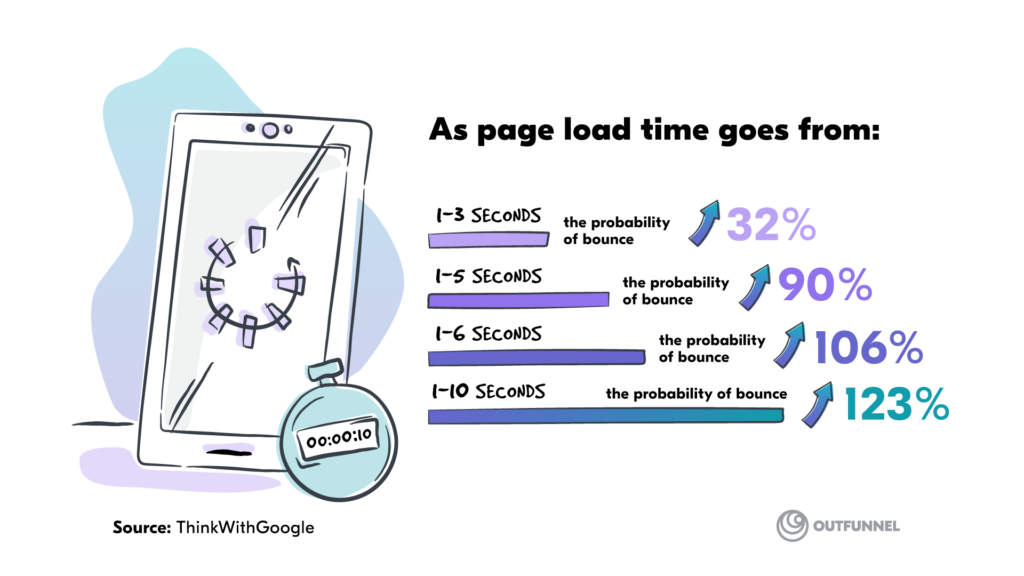
And, while we’re on the subject of loading times… It’s probably no surprise that the longer your page takes to load, the higher the probability your visitors will just up and leave before they get to the good stuff.
This is worth a whole post on its own but here’s a quick tip. Head to Google’s PageSpeed Insights and see how your home page (and most important pages) score.
Keep in mind that how your site fares here has a direct impact on how it ranks. Which directly impacts your ability to generate B2B leads.
8. Optimize for your mobile traffic
Google’s made a lot of noise over the last few years about the importance of mobile. In fact, the PageSpeed Insights score actually prioritizes mobile performance.
The graph below is for ad revenue (rather than pure “traffic”) but it still paints a pretty clear picture. If your sales and marketing approach is treating mobile as the bastard step-child of desktop, then you’re missing out.
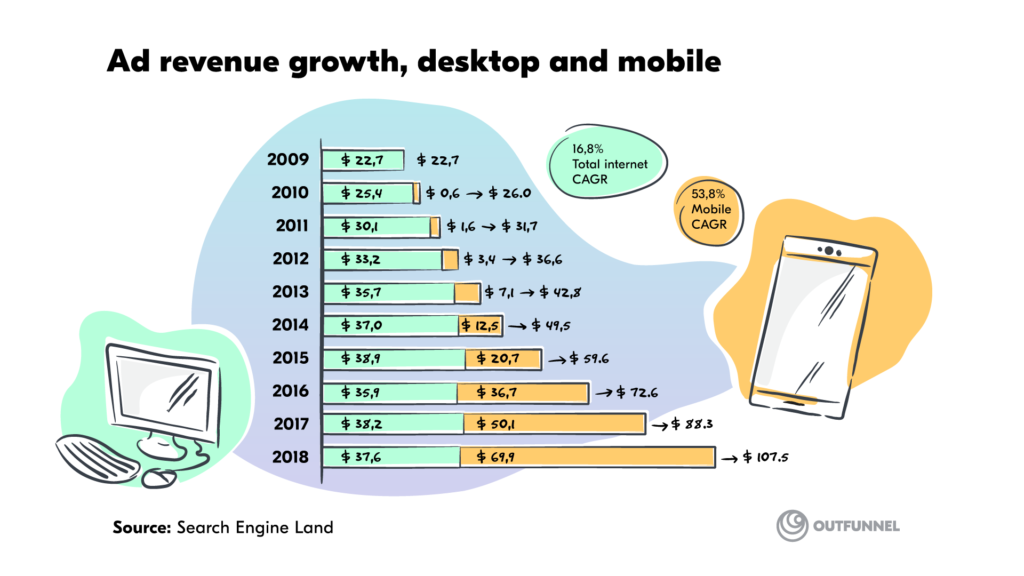
Even simple stuff, like making sure your site is clear and easy to navigate on a handheld device. Make sure forms, you know, work. Many B2B sites on mobile are an assault on the eyes, with myriad pop-ups for consent, live chat tools, competing CTAs and interstitials. Yes, you can get away with that on desktop, but on mobile you have a lot less real estate to play with.
Maybe consider changing out that screen-filling lead capture form that appears on every page with something that appears “in-feed” as they scroll through your article or landing page?
9. Hunt down competing leads
What do I mean by competing leads? Well, for example, say you had a lead that fell through—an agency based in New York.
If you’ve got a little bit of technical or analytical skills, you can create competitor reports. These are based on the profile of that particular business and build a targeted list of who you can go after.
I won’t go into too much detail, because frankly, this SEMrush article on the topic covers everything you really need to know.
10. Better quality (and more) backlinks
While I am still on the topic of SEO (search engine optimization) tips that can help you land more leads, I’d be foolish not to mention backlinks.
If you want your good quality content and landing pages to start generating you leads, you need people to be able to find it. You can pay to promote it (more on that in a second), but really, for the best return, you want a load of organic visitors reaching your content.
And, well, backlinks are, arguably the single most important factor when it comes to how your content ranks.
So, how do you get more backlinks, while keeping them decent quality?
Well, you can pay someone. There are a lot of services out there where you can hand over some cash in exchange for links from domains of varying “authority”. This can be kinda sketchy though, to be honest.
A few of the most common ways of getting backlinks, are:
- Guest posting: offer to create content for other blogs, then use that to link back to your own site.
- Broken links: use a tool to find anchor text containing your keywords where the destination URL is no longer available. Reach out the author and point out the broken link while suggest your own as a replacement.
- Relevant outreach: reach out to bloggers, content creators, B2B marketers etc who’ve done posts containing products or services similar to your own and ask to be included. This happens a lot with SaaS companies creating “best of” lists. In my experience, if you start chatting with them you’ll have a very strong chance that they’ll add a link for you.
So, while backlinks by themselves aren’t to be delivering leads, without them your lead generation content is likely to be dead in the water.
11. Google search ads
Google search ads. The pinnacle of paid, B2B lead generation, right? Everyone’s throwing their cash at Google to get their brand to that all-important top spot. This must be because it delivers an awesome return on ad spend, right?
Wrong.
Turns out just 6% of keywords in the average Search Ads account have ever delivered a conversion (form fill, chat, call, etc.). That’s 94% of keywords in Search Ad accounts sitting there, doing nothing.
Well, they’re doing worse than nothing actually. They’re costing money.
So, why would I suggest you use Google Search Ads to generate leads for your business?
Well, if you can nail the 3 T’s of Search Ads: Time, Targeting, and Tracking, you will end up with an extremely powerful lead generation engine powering your business.
12. Facebook, LinkedIn, Google Ads and other PPC display ads
Much like their text-based counterparts, banner (or display) ads across almost any channel can be a viable B2B lead generation source, but they take a good deal more effort.
They still need the same attention to detail when it comes to time, targeting, and tracking. But unlike text-only ads, display ads only really work when you have a great creative too.
Being able to produce great banner ads really depends on the amount of resources your marketing team has at their disposal. More specifically, whether they’re able to come together with sales to figure out what the best messaging should be, what offer you might be able to use, then go out and make something great.

B2C, display ads are pretty much a requirement. But with B2B, things are a little more complicated.
My advice is this: if you have a single-person marketing team, and a handful of sales-people, steer clear of sinking a lot of time and money into display ads.
If you have some budget and want to try something with a relatively low-effort, then the first step could be retargeting your site’s visitors with some high-quality, lead magnet content.
And if you want to go all-in to trying PPC, consider getting a marketing agency specialized in paid acquisition to help you out.
13. Give away your product or service
One of the biggest names in digital marketing got their early traction by giving away a free tool: HubSpot.
While it wasn’t their core product it was useful enough for people to be willing to hand their contact details over for and, this is the important part, share a link for the tool itself.
The first tool they gave away was a website grader, then they rolled out more and more. This, of course, was paired with a pretty feature-rich trial, that was just extensive enough for an early business to be able to build their sales pipeline with.
Then they nurtured these leads, with seemingly endless content, to convert them into paying customers.
14. Launch a super-basic MVP
This one is mainly aimed at early-stage, SaaS businesses but not exclusively. There are plenty of examples of service-based companies, like agencies, switching over to a product (I used to work at one!).
Launching a really pared down version of your product early kills many birds with a single stone.
You can start generating qualified leads. You get to test product-market fit. You get to figure out what sort of features you should prioritize based on the actual needs of your potential customers.
An example that springs to mind is web-based video SaaS, Loom. When they first went to market, it was super-basic, with just the features you need. It was free as well, with their argument being that they didn’t think the business landscape was quite ready for them to start asking for money.
It didn’t stop them going out and gathering up leads though.
And, of course, Outfunnel.
When Outfunnel first launched it pretty much did a single thing. Connected Mailchimp to Pipedrive. The longer term vision was much more fully featured than that, of course, but why wait potentially years to build it, burning through money, when you can start generating leads, and securing your business, while at the same time letting the market guide the product development process?
Next, let’s take a look at some offline B2B lead generation ideas.
Offline B2B lead generation strategies
All of the ideas and examples so far have been online. But what if you want to do things in the real world? Maybe you’re a single-person show and don’t have an army of marketers to help you? Or you don’t have the resources to build a detailed 6 month content plan to start generating high-quality leads?
Well, you can always hit the pavement.
15. Just show up
There’s a great anecdote about how fellow Estonian startup-turned-unicorn, Bolt got their first customers in the early days.
Their founder, Markus Villig needed to find taxi drivers to add to their platform, a ridesharing app. So, every day he went down to the taxi ranks in Tallinn and started knocking on cab drivers windows, asking them if they wanted to sign up.
In some cases, he got some pretty hard no’s, but he persevered. He got his early leads that were vital to the ultimate success of the business.

Markus Villig, youngest founder of a billion-dollar company in Europe. Image source
The point is sometimes, whether you’re a very early-stage startup, or a more established business, sometimes there’s a lot of value in just turning up. You don’t need to necessarily sell on the spot, you can just get them signed up for more info.
This in particular is a great example of how you can turn the standard “marketing first, then sales steps in” approach of the sales funnel. The whole process should be owned by both sales and marketing together.
In this instance, sales tactics would work better to harvest the new leads. Then, marketing can step in to do a bit of nurturing, building up trust, before sales steps back in to seal the deal.
16. Pick up the phone
Cold calling may seem a bit, well, icky to some, but I wouldn’t discount it as a potentially effective lead generation strategy. Start with using an email finder plugin to make sure you have the most up-to-date contact information.
Research your prospects before picking up the phone, so you can answer that all-important question:
“How is this thing going to help me?”
Ideally, you should have some sort of script, at least to open with, and use it as a sort of guide throughout the call. Think of less a script and more as a kind of cheat sheet,
Then as you get more experienced, you’ll be able to be much more dynamic on each cold call.
It has a pretty dodgy reputation and it isn’t for everyone, but if you have the gift of the gab, then don’t be afraid to pick up the phone.
17. Go to better events (and do them better)
At the time of writing, events are pretty much over for this year for most of us. The global pandemic completely decimated everyone’s calendars.
But I doubt they’re all going to go away forever. A lot of events will probably move online. Now is the perfect time to really dig in and figure out what events you should be going to when they start to open up again.
Lead generation is most businesses top priority when going to events. In this, it’s vital that your sales and marketing are both working in perfect harmony. Both need to share insights with each other to figure out which events to go to.
Depending on your industry, actually closing deals on the floor at a tradeshow might be a bit of a stretch. Instead, use it as an opportunity to get sales to have a conversation with prospects, then pass their details onto marketing so they can nurture them, if they need it.
And don’t forget, if you’re paying to attend an event, more often than not you’ll have access to the contact database for that event. Don’t waste that.
If you’re looking for some insights on how to handle post-event marketing and follow ups, we got you. Check out this comprehensive email marketing teardown, full of useful pointers and best practices.
The TL;DR of lead gen
In a hurry? Here’s a recap of what to bear in mind when considering different lead generation strategies:
- Don’t panic if you don’t know exactly where your leads are coming from.
- Remember the “7 P’s”: Prior preparation and planning prevent piss poor performance.
- High quality content marketing and automated email marketing are likely to be where you want to focus your efforts.
- Tradeshows have taken a hit, but they will be back. Spend this downtime perfecting your event (and post-event) sales process and marketing strategy.
- Google search ads are worth it only if you invest time. Fix your targeting, and have nailed your tracking, otherwise you’re probably burning money.



